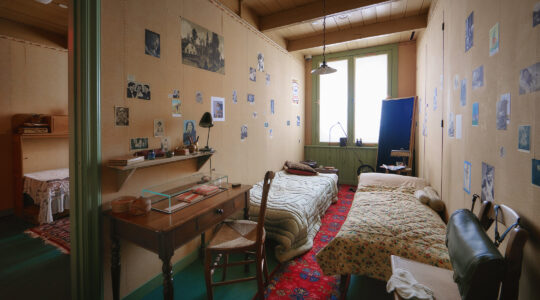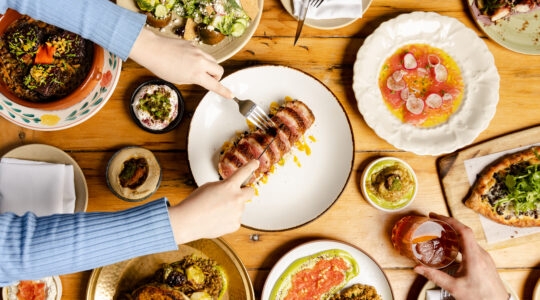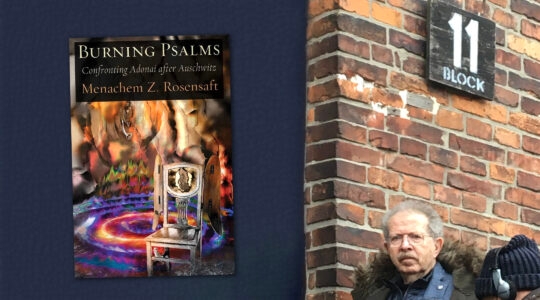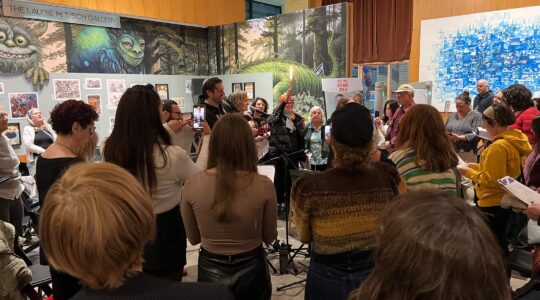If he could, my husband would order shrimp and cholent in the same meal.
Alas, even New York doesn’t have a restaurant that offers both on the same menu. But if there were such an establishment, you’d be sure to find my husband happily chowing simultaneously on glatt kosher and glatt treif. Yes, he’s a guy conflicted about his Jewish identity. It’s one of the vestiges of being a FFFB (formerly-frum-from-birth) guy who revels in the remnants of his rebellion.
Growing up in an assimilationist home, and then attending high school at a more-than-nominally Presbyterian boarding school, I never imagined I’d be married to a former Lubavitcher. But nearly a decade into marriage here we happily are.
It’s been a “mixed marriage” in many ways, between two people from nearly opposite ends of the religious spectrum, and we’ve had to work to find ways to accommodate each other’s religious inclinations.
Back when we met we were both living essentially secular Jewish lives, though I had dabbled in learning at a couple of Israeli yeshivas. I found Marc’s background appealing, since I hoped to find a Jewishly literate guy. The differences in our backgrounds became dramatically apparent when I first met his family.
As soon as we arrived Marc’s stepmother took me to Lubavitch headquarters. In a long line of women who didn’t share my need for personal space, I was jostled in the door and up the stairs, where the Lubavitcher rebbe was distributing crisp singles. I’d heard stories about the mystical rebbe, that he would turn his intense blue-eyed gaze on you and intuit which of the several languages in which he was fluent to speak to you.
But when I reached the rebbe he looked at me fleetingly, blessed me in Yiddish-inflected Hebrew that I couldn’t comprehend, and handed me two dollars.
As we left the building, my mother in law grabbed me excitedly and asked, “Did you hear what he said?” Since I hadn’t, she told me that he offered me a special blessing given only when something like marriage was imminent, and that the two dollars also indicated his prophecy about my future.
It turns out that the rebbe was right.
And ever since, my union with Marc has been a real adventure in inter-denominational understanding.
Our wedding, for example, was not what I would have liked it to be. Finding a caterer who was acceptably kosher to Marc’s family and acceptably contemporary to us was no small challenge. Their favorite candidate got shown the door as soon as he revealed that his specialty was Tongue Polonaise. Eventually we found someone who satisfied us all, though she had to buy the fish from my mother-in-law’s favorite fish store.
I desperately tried to find a role for my sister besides that of the lieutenant holding my flowers as I was acquired under the chupah. She was forbidden even to hold a chupah pole but I quietly told her to be the guard outside the room where we would spend our first moments as a married couple. So she did, until a new brother-in-law all but shoved her out of the way because in his view, that role had to be filled by someone “kosher.” That is, a man.
Forget about the ketubah. It’s beautifully decorated but empty of our values as an egalitarian Jewish couple.
The one thing on which we did hold sway was that Marc would wear a wedding ring, contrary to ultra-Orthodox custom decreeing it too similar to the dress of women to be appropriate. Intense negotiations with the rabbi led to an agreement in which I could put it on Marc’s finger, but was only permitted to say, “I am my beloved’s and my beloved is mine.” It had to come after the “real” ceremony was concluded, and just to emphasize the distinction, the rabbi stepped down off the bima right before I gave Marc his ring.
The first years of marriage were challenging as Marc and I tried to find common Jewish ground. He wanted to keep going to the nearly defunct Orthodox synagogue where we were married, the few times a year that he went. I wanted to find a community of young people in an egalitarian setting where my voice would be heard.
I worked in a job where I was learning more about the possibilities of being observant in a modern way even as Marc still needed distance from religious Judaism. Any observance, for him, was the kind that had been shoved down his throat as a child.
We both felt comfortable in the first synagogue we tried, a lively, largely lay-led community of Jews from every possible background, with a lot of refugees from Orthodox life and an equal dose of tie-dye.
I began going regularly, but Marc wouldn’t come except for the big holidays. It felt lonely, being at shul without him. I was also making friends alone that I wanted us to be making as a couple. I worried that we weren’t developing enough of a shared life.
But time, patience and effort on both our parts have led to today’s reality.
Marc is a leader of the junior congregation, where he teaches grade-schoolers how to participate in the service. And no one enjoys it more than our son, who glows with pride when he’s standing next to his father at the front of the service.
It took me a long time (and more than a few arguments) to realize that I had to let my husband be who he is. Now, when he relates in lip-smacking detail the latest calamari appetizer and lobster entree he had at a business dinner, I enjoy his pleasure. And he agreed (after more than a few arguments) not to order glatt treif in front of our children.
Early on Marc resisted the idea of any Sabbath observance, so I began lighting Shabbat candles and we made Friday the night we invited people to dinner. Today, for all of us, it is the highlight of our week. Thankfully we both favored sending our children to Jewish day school.
But, as with any married couple, we continue to have our differences. I’d prefer more of a Shabbat atmosphere at home, which can only be accomplished when everyone is tuned in to the same slow rhythm of the day. I won’t do anything commercial. But Marc sometimes picks up his dry-cleaning on Saturday afternoon or does another errand with our kids in tow.
I also aspire to greater consistency in my observance of kashrut. This week we were divided on whether to bring kosher meat to the non-kosher beach house we’re soon renting. No surprise here — I’m in favor of it and Marc is not. Rationally he’s got the stronger case, I know, but the jury’s still out.
This past decade has also been a wonderful journey to a place of great mutual respect between us and Marc’s family. Six years ago they pressed us hard, but unsuccessfully, to hold our son’s brit milah in an Orthodox setting rather than our Conservative synagogue. But last year they found a way to participate in our daughter’s simchat bat (naming ceremony), even though it was foreign to their religious sensibilities. For that, I am deeply grateful.
I’ve also come to like that our children are exposed to the entire spectrum of Jewish observance within our one little family. They learn the most rigorous religious standards when they’re with Marc’s family even as they get to do fun things like go with Zeyde to bake shmurah matzah in the weeks before Passover. The following month they might be at Friendly’s, ordering hamburgers and milkshakes with my father, their Pop-Pop.
As an Orthodox friend of mine reminded me after I bemoaned the inconsistencies between Marc and my approaches toward observance, it’s not the end of the world for our children to grow up exposed to both.
Perhaps, in the end, it will even help them be tolerant of the diversity among the larger family of Jews.
The New York Jewish Week brings you the stories behind the headlines, keeping you connected to Jewish life in New York. Help sustain the reporting you trust by donating today.




